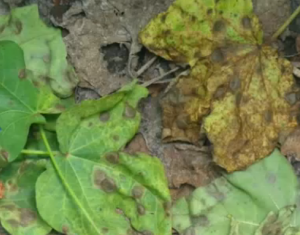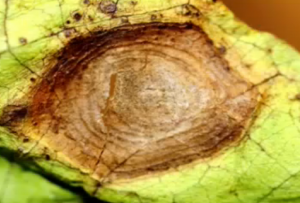By Katie Nichols
Target Spot is a foliar disease southern farmers combat in cotton nearly every year. With dry weather in the past few years the disease has been held at bay, but irrigated cotton has suffered a substantial amount of damage no matter the weather conditions.
Target spot is a true leaf spot disease. Spotting on cotton will be visible between the first and third weeks of bloom. The wetter the weather, the faster it spreads.
Alabama Cooperative Extension System Plant Pathologist, Austin Hagan said after the onset of the disease, cotton leaves drop quickly.
“In one case we saw spotting on a few leaves at the base of the canopy in the third week of bloom,” Hagan said. “Six weeks later almost 90 percent of the foliage was on the ground.”
Disease Factors and Risk Zones

Target spot issues are more prevalent in the southernmost parts of the state—near the coast. In Central Alabama the risk is still there, depending on weather patterns and irrigation. In North Alabama, the threat is generally low, even on a susceptible line.
Factors influencing the disease include irrigation, high nitrogen, canopy closure and cotton variety.
Producers pushing the yield envelope will irrigate frequently and apply high rates of nitrogen. While this does likely increase yield, it also creates an environment where rapid canopy closure and production of rank top growth is likely. All of these factors, plus the cotton variety type may be a perfect recipe for target spot. If the canopy does not close, as is often the case on dryland cotton, producers are less likely to see target spot.
Yield Impacts
Hagan said research has shown at least 400 pounds of lint per acre lost due to target spot in a susceptible cotton variety. Losses in resistant lines are much smaller.
“We tend to see a reduction in disease on most varieties we work with when treated with a fungicide, “ he said. “We consistently get a yield bump with fungicide applications in susceptible varieties when defoliation levels are high.”
In many situations the gin-out percentages are higher, meaning the value of cotton treated with a fungicide is higher.
Fungicide Use Guidelines

Hagan said it is important to monitor weather patterns because target spot is driven by wet weather and irrigation.
When applying fungicide, target fields with rapid canopy closure and good yield potential. Research conducted by Hagan and his colleagues has shown a minimal increase in yield when applying fungicide to cotton without promising yield prospects.
Finally, Hagan said producers should remember the wetter the weather, the better for target spot.wet spot issues in cotton.
Application timing is as important as spotting the disease in the field. While the label says to apply at the first week of bloom, Alabama Extension researchers suggest applying a fungicide during the third week of bloom and reapplying two to three weeks later.
The other option is to scout and apply fungicide at the first sign of the disease, following up with a treatment 14 days later. Hagan said this method will depend on weather patterns and other factors.
Source:aces.edu